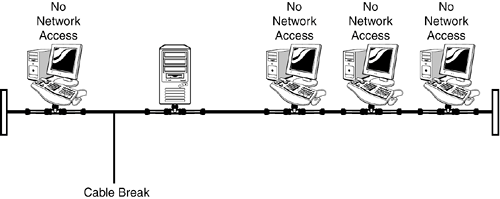-
A bus topology must be continuous. A break in the cable at any point will render the entire segment unusable. If the location of the break in the cable is not apparent, you can check each length of cable systematically from one end to the other to identify the location of the break, or you can use a tool such as a time domain reflectometer, which can be used to locate a break in a cable.
-
The cable used on a bus network has two distinct physical endpoints. Each of these cable ends requires a terminator. Terminators are used to absorb electronic signals so that they are not reflected back on the media, compromising data integrity. A failed or missing terminator will render the entire network segment unusable.
-
The addition, removal, or failure of a device on the network might prevent the entire network from functioning. Also, the coaxial cable used in a bus network can be damaged very easily. Moving cables in order to add or remove devices can cause cable problems. The T connectors used on bus networks do allow devices to be added and removed without necessarily affecting the network, but care must be taken when doing this.
-
One end of the bus network should be grounded. Intermittent problems or a high occurrence of errors can indicate poor or insufficient grounding.
Figure 3 shows how a single cable break would affect other client systems on a bus network.
Figure 3 Identifying cable breaks in a bus network.